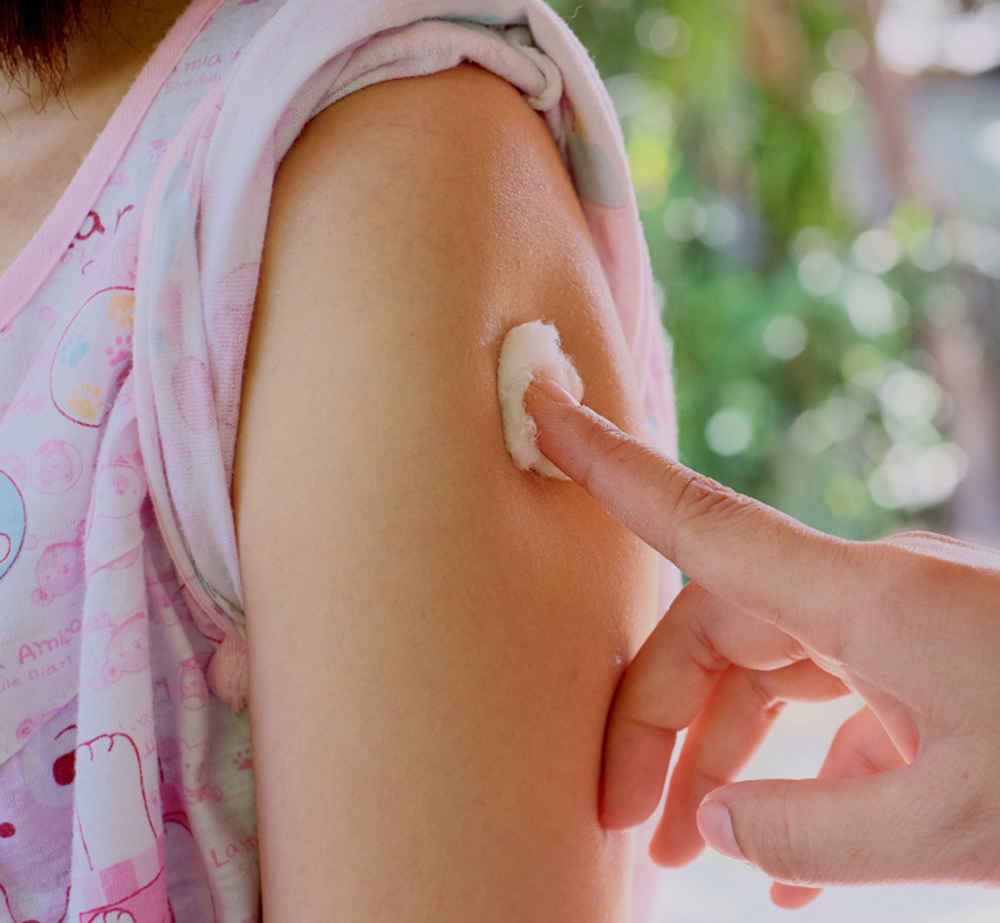410-721-2273
Insect Bites
What insects cause itchy or painful bites?
Bites of mosquitoes, chiggers (harvest mites), fleas, and bedbugs usually cause itchy, red bumps. The size of the swelling can vary from a dot to a half inch. The larger size does not mean that your child is allergic to the insect bite. Mosquito bites near the eye usually cause a lot of swelling for 2 days.
Signs that a bite is from a mosquito are: itchiness, a central raised dot in the swelling, a bite on skin not covered by clothing, and summertime. Infants are more likely to be bitten because they can't protect themselves. Some mosquito bites in sensitive children form hard lumps that last for months.
Fleas and bedbugs tend to bite skin under clothing. Flea bites often turn into little blisters in young children.
Bites from horseflies, deerflies, gnats, fire ants, harvester ants, blister beetles, and centipedes usually cause a painful, red bump. Fire ant bites change to blisters or pimples within a few hours.
How can I take care of my child?
Itchy insect bites
Apply calamine lotion or a baking soda paste to the area of the bite. If the itch is severe (as with chiggers), apply nonprescription 1% hydrocortisone cream 4 times a day. Do not use Benadryl cream. Another way to reduce the itch is to apply firm, sharp, direct, steady pressure to the bite for 10 seconds. A fingernail, pen cap, or other object can be used. Encourage your child not to pick at the bites or they will leave marks.
Painful insect bites
Soak a cotton ball with a baking soda solution and apply it to the bite for 20 minutes. This will reduce the pain. You can also apply cold, moist compresses or ice on the area. Give acetaminophen or ibuprofen for pain relief.
How can I help prevent bites?
Mosquitoes and chiggers
To avoid mosquito bites or tick bites, keep the body covered. Stay away from where mosquitoes breed. Many of these bites can be prevented by using an insect repellent such as DEET or permethrin before your child goes outdoors or into the woods. Always use repellents for infants less than 1 year old because they cannot bat the insects away.
Bedbugs
Thoroughly clean areas where bed bugs might hide, such as mattresses, bedding, base boards, door frames, and floor boards. Look for black or brown spots of dried insect fecal material. Vacuum the mattress, paying close attention to tucks and along seams. Be sure to dispose of the vacuum cleaner bag right after the cleaning.
You may need to call in an exterminator. If you decide to spray for bed bugs yourself, use an insecticide that is specifically labeled for bed bugs. NEVER USE INSECTICIDE ON A MATTRESS.
Fleas
Usually you will find the fleas on your dog or cat. If the bites started after a move into a different home, the fleas are probably from the previous owner's pets. Fleas can often be removed by bringing a dog or cat inside the house for 2 hours to collect the fleas (they prefer living on the dog or cat to living in the carpet) and then applying flea powder or soap to the animal outdoors. Careful daily vacuuming will usually capture any remaining fleas.
What kind of insect repellent should my child use?
There are two main types of insect repellent. Repellent used on the skin and repellent put on clothing. Repellent used on the skin contains a powerful ingredient called DEET. Repellent used on clothing uses an ingredient called permethrin to repel insects. Both are useful for preventing bites.
Insect repellents for skin
DEET
DEET is a very effective ingredient used to repel mosquitos, ticks and other bugs. When using a product containing DEET, follow these precautions:
- The percentage of DEET in a product tells you how long it lasts, not how strong it is. Use a repellent with 30% DEET for children and teens. 30% DEET protects for 6 hours. Use products containing 10% DEET if you only need protection for 2 hours. The American Academy of Pediatrics has approved the use of 30% DEET or less for children over 2 months of age.
- Do not use products with DEET in children younger than 2 months old. Breast-feeding women may use DEET. DEET should not be applied more than once per day.
- Do not put too much repellent on. A total of 3 or 4 drops can protect the whole body.
- Only put the repellent on exposed areas of skin. Be careful not to get DEET on clothing. DEET can damage clothing made of synthetic fibers, plastics (for example, eye glasses), and leather. DEET can be used on cotton clothing.
- Do not put DEET on the eyes or mouth. Don't put DEET on your child's hands if your child sucks his thumb or fingers.
- Don't put any repellent on skin that is sunburned or has a rash because the DEET is more easily absorbed in these areas.
- Remember to wash the repellent off with soap and water when your child returns indoors.
Other skin repellents
Other insect repellents are as effective as 10% DEET. They include Picaridin (from Cutter) and oil of lemon eucalyptus. Oil of lemon eucalyptus is not approved for children under 3 years old. Both picaridin and oil of lemon eucalyptus can safely be used on skin or clothing.
Insect repellent for clothing: Permethrin
Permethrin is an insect repellent that is sprayed onto clothes. Duranon, Permanone, and Congo Creek Tick Spray are examples of products that contain permethrin. They are good for repelling mosquitoes and ticks. Apply permethrin to shirt sleeves, pants cuffs, shoes, and hats. You can also put it on other outdoor items (mosquito screen, sleeping bags). Do not put permethrin on skin because it does not work well on skin.
Call 911
Call our office immediately if:
(410) 721-2273
Call us during office hours if:
- Itching or pain is severe after treatment.
- You have other questions or concerns.
Written by B.D. Schmitt, MD, author of "Your Child's Health," Bantam Books.
This content is reviewed periodically and is subject to change as new health information becomes available. The information is intended to inform and educate and is not a replacement for medical evaluation, advice, diagnosis or treatment by a healthcare professional.
You May Also Like
Popular Resources | Make an Appointment • Locations • Refill Prescriptions





